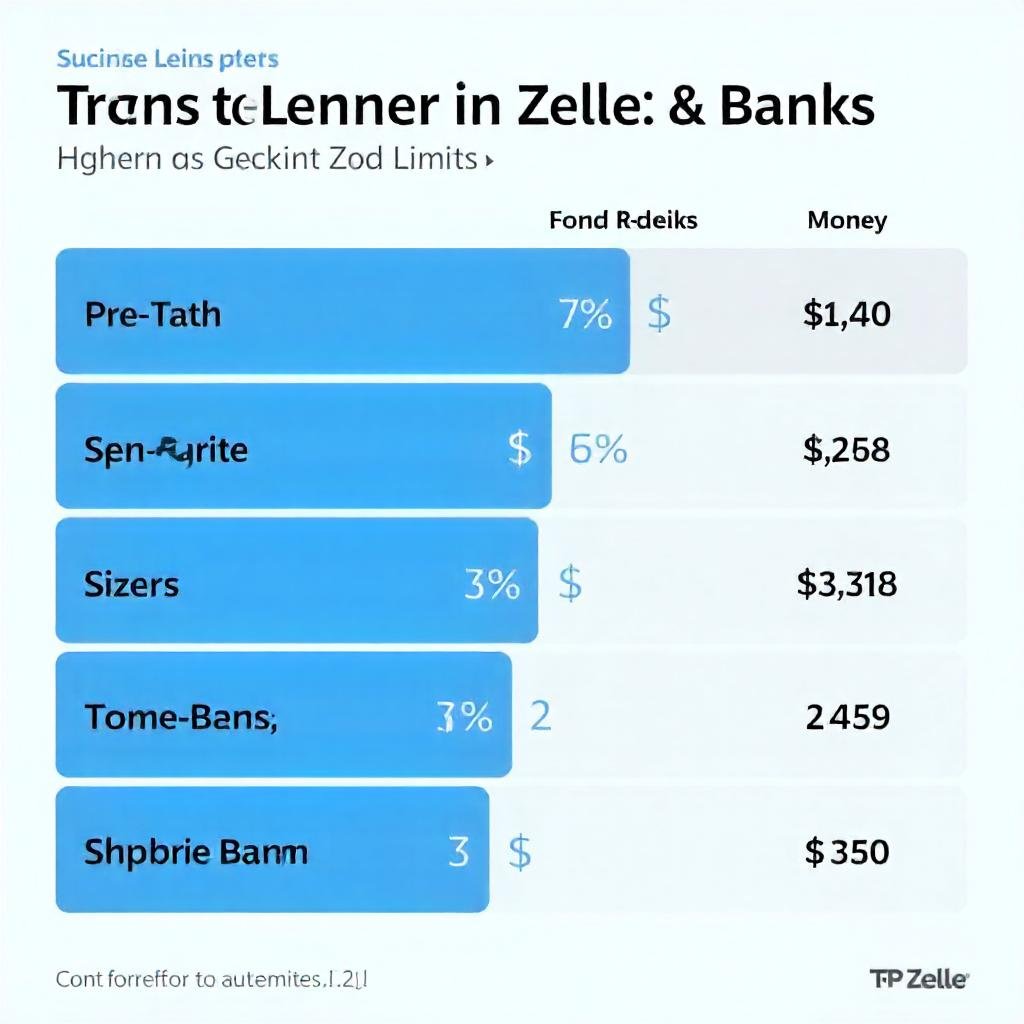
Zelle Limits at Top Banks
Zelle transfer limits vary significantly across top banks, affecting how much money users can send or receive daily and monthly. These limits depend on the bank’s policies and the user’s account type, with some banks allowing higher transfers for certain customers.
Most major banks set daily Zelle limits between $1,000 and $3,500, while monthly limits typically range from $10,000 to $20,000. Understanding these limits can help users avoid declined transactions and better plan their money transfers.
Knowing the specific limits at your bank can save time and prevent frustration during urgent transfers. This article outlines the Zelle limits at leading banks to clarify what users can expect.
Understanding Zelle and Transfer Limits
Zelle allows quick transfers between bank accounts using email or phone numbers. Its limits vary by bank, often divided into daily, weekly, and monthly caps. These restrictions help banks manage risk and protect customers.
How Zelle Works
Zelle is a digital payment service linked directly to users’ bank accounts. It enables near-instant transfers to recipients who also use Zelle, typically within minutes. No fees apply when sending or receiving money, making it convenient for peer-to-peer payments.
Users enroll through their bank’s app or the Zelle app. Transfers require only the recipient’s email or phone number, eliminating the need for account numbers. It connects to participating banks such as Chase, Bank of America, Wells Fargo, and others.
Types of Zelle Limits: Daily, Weekly, and Monthly
Zelle limits vary significantly between top banks. These limits often include:
| Limit Type | Typical Range at Top Banks |
| Daily | $1,000 to $2,500 |
| Weekly | $1,000 to $20,000 |
| Monthly | Available at some banks, up to $50,000 |
For example, Bank of America sets a daily send limit around $2,500, while Chase offers roughly $2,000 daily. Wells Fargo’s weekly limit can reach $15,000. Some banks combine limits, restricting either daily or monthly totals depending on account type.
Understanding limits is crucial for planning large transfers and avoiding declined transactions.
Why Banks Set Zelle Limits

Banks set Zelle limits to reduce fraud risk and limit financial exposure in case of unauthorized use. Limiting the size and frequency of transfers helps detect suspicious activity sooner.
Additionally, Zelle limits prevent users from moving large sums too quickly, which is important for regulatory compliance. Banks balance customer convenience with protecting both parties in the transaction.
Limits can also reflect customer account history, transfer behavior, and account type, resulting in personalized caps in some cases. These rules keep the system secure and stable across all major financial institutions.
Zelle Transfer Limits at Top U.S. Banks
Transfer limits through Zelle vary significantly across major U.S. banks. Daily, weekly, and monthly caps depend on the bank’s policies, account type, and customer status. These limits impact how customers manage peer-to-peer payments.
Zelle Limits at Wells Fargo
Wells Fargo sets its Zelle transfer limits based on customer history and account type. New customers usually start with a daily send limit of $2,500. Established customers can send up to $5,000 daily.
The weekly limit at Wells Fargo typically reaches $10,000. There is also a monthly cap of $20,000 for most account holders. These limits apply to personal checking accounts.
Wells Fargo does not publicly detail transfer limits for business accounts on Zelle, but they generally have higher thresholds. Customers should check their Wells Fargo online banking for specific limits and updates.
Zelle Spending Caps at Chase
Chase bank applies tiered Zelle limits based largely on the account type and customer relationship. Chase personal checking accounts typically have a daily send limit of $2,000.
The weekly send limit at Chase is around $16,000, while monthly limits can reach $40,000 for eligible customers. Chase Business accounts often have distinct limits, often higher than personal accounts.
Chase routinely encourages customers to verify limits inside its mobile app or online banking portal. Limits can adjust based on fraud risk and account tenure, making them flexible yet generally high.
Bank of America Zelle Limits
Bank of America enforces Zelle daily send limits usually between $2,500 and $3,500 for most personal checking accounts. The maximum weekly transfer is often capped near $10,000.
Monthly sending limits at Bank of America hover around $20,000. These limits can increase for customers with higher deposit balances or longer banking relationships.
Bank of America’s limits also apply cautiously to newly enrolled Zelle users, often starting lower and increasing with account age and activity. Limits for business customers differ and usually require consultation with bank representatives.
Zelle Limits at Citibank and U.S. Bank

Citibank sets Zelle limits with a focus on account type and customer activity. For most personal accounts, daily Zelle send limits are $2,000 to $3,000. Weekly limits often max out near $10,000.
U.S. Bank offers daily send limits of about $2,500 for personal accounts using Zelle. Weekly caps commonly fall between $10,000 and $15,000, varying by customer profile.
Neither Citibank nor U.S. Bank publicly discloses specific monthly limits, recommending users check their online banking for exact figures. Both banks also maintain different limits for certain business accounts and some larger credit unions they serve.
Zelle Limits at Credit Unions and Regional Banks
Many credit unions and regional banks have specific limits on Zelle transactions. These limits depend on factors such as the institution’s size, member relationship, and account type.
Credit Union Zelle Restrictions
The 10 largest credit unions in the US, like Navy Federal Credit Union and State Employees’ Credit Union, have daily Zelle limits typically ranging from $1,000 to $3,000. Monthly caps often fall between $5,000 and $10,000. These limits can be lower for new members or accounts under 30 days.
Some credit unions use tiered limits, increasing the cap after a set number of successful transactions or account age milestones. For example, Pentagon Federal Credit Union starts with $1,000 per day and may raise it to $2,500 after verification steps.
Member loyalty and account standing sometimes influence limits. Certain credit unions require Zelle users to register a phone number or email address tied to the member’s profile before enabling transfers.
Regional Bank Zelle Policies
Regional banks such as PNC and SunTrust have Zelle limits generally higher than credit unions, with daily transaction caps around $2,500 to $5,000. Monthly limits commonly extend up to $20,000, reflecting larger customer bases.
Some regional banks enforce stricter limits during the initial account or Zelle enrollment period, for example, $500 daily for the first 14 days. Afterward, limits increase based on account activity and risk assessments.
Banks like Regions Bank may set different limits depending on whether the transfer is to an external party or another account within the same bank. Internal transfers often have higher or no limits. Additionally, regional banks apply multi-factor authentication to reduce fraud risks affecting limit policies.
Factors Influencing Zelle Transaction Limits
Zelle transaction limits vary based on multiple factors such as account details, user verification status, and the specific bank’s rules. These elements determine how much money can be sent or received daily or monthly, impacting users’ overall experience with the service.
Account Type Impact on Limits
Many banks differentiate Zelle limits depending on whether the account is personal or business. Personal accounts usually have lower sending limits while business accounts may receive higher thresholds to accommodate larger transactions.
For example, some banks set daily limits for personal checking accounts at $1,000 to $2,500. Business accounts might have daily limits of $5,000 or more. Furthermore, savings accounts often have stricter limits or may not support Zelle transactions due to federal regulations on withdrawals.
Higher-tier account holders may also benefit from increased limits. Premium or private banking clients at some institutions can access enhanced Zelle capabilities as part of their account privileges.
User Verification and Limit Changes
Verification levels significantly influence Zelle limits. Users who complete multifactor authentication, link verified bank accounts, and provide personal information can access higher transaction amounts.
New users or those with unverified identities generally face stricter daily and monthly limits. Once identity verification is confirmed, the bank may raise limits to standard or premium levels.
Some banks periodically review accounts for suspicious activity, adjusting limits accordingly. User history and credit-related data indirectly affect these decisions, though Zelle itself does not require credit checks. Keeping personal details updated can ensure smooth limit adjustments.
Bank-Specific Policies and Limit Adjustments
Each bank sets its own Zelle policies, creating wide variability in limits. Some banks impose static limits, while others adjust dynamically based on account tenure, transaction history, or risk factors.
For instance, Bank of America caps daily Zelle transfers at $2,500 for most users, but offers up to $10,000 for eligible customers. Chase has a $2,000 daily limit for many customers, with some exceptions.
Policies around frequency, cumulative monthly limits, and unique restrictions on transfers to new recipients also vary by institution. Customers should consult their banks directly to understand specific rules and potential for limit increases.
Tables or lists comparing limits at major banks often help users decide which bank meets their Zelle transaction needs.
How to Increase Your Zelle Transfer Limit

Increasing a Zelle transfer limit requires specific actions and meeting certain conditions set by your bank. These often involve a formal request and verification of eligibility based on your account history and activity.
Steps for Requesting a Limit Increase
To request a higher Zelle limit, the user usually needs to contact their bank directly. This can be done through the bank’s mobile app, online banking portal, or by calling customer service.
Some banks provide an option within the app to request a limit increase. The user may need to fill out a form or submit a request explaining their need for a higher limit.
After the request, the bank reviews account activity and identity verification. The decision can take from a few hours to several business days.
In some cases, providing additional documentation, such as proof of income or verification of business status (related to EIN verification), might be required.
Eligibility Criteria for Higher Limits
Eligibility for a higher Zelle limit often depends on account age and transaction history. Users with longer active accounts and no history of suspicious activity have better chances.
Banks may require users to have accounts in good standing, with consistent deposits and withdrawals. Some require a minimum credit score or banking relationship duration.
For business accounts, having a valid EIN that can be verified online might be necessary. This helps banks ensure the account is legitimate.
Users cannot typically increase limits multiple times in a short period. Banks closely monitor requests to prevent fraud or money laundering.
Maintaining a strong credit score also positively influences eligibility, as banks consider overall risk profiles when approving limits.
Comparing Zelle to Other Money Transfer Options
Zelle is popular for its speed and bank integration but has specific limits that differ from other services. Understanding these differences helps users choose the best option based on transfer size, fees, and international needs.
Zelle vs. Venmo and PayPal Transfer Limits
Zelle’s transfer limits vary by bank but typically range from $500 to $2,500 per day. Some top banks like Chase allow up to $2,000 daily, while Wells Fargo usually limits users to $2,500. These limits reset every 24 hours and vary if the user is new or established.
Venmo and PayPal offer higher transfer limits after identity verification. Venmo caps personal transfers at $6,999.99 per week. PayPal’s sending limit can be up to $10,000 per transaction or around $60,000 monthly for verified accounts. Unlike Zelle, both may charge fees for instant transfers or business payments.
Bank Wire Transfer Limits
Bank wire transfers typically have higher limits than P2P apps like Zelle. Most banks set daily or per-transfer caps between $10,000 and $50,000 for standard wires. Some institutions allow wire transfers exceeding $100,000 but require additional verification.
Wire transfers often carry fees ranging from $15 to $50 domestically and higher for international wires. Unlike Zelle, wires are slower, taking 1-3 business days. They are preferred for large, one-time payments due to their security and higher allowances.
Foreign Transaction Limit Considerations
Zelle is limited to transfers within the U.S. and cannot handle foreign currency exchanges or international payments. This restricts its use for users needing cross-border transfers.
Foreign transaction fees typically apply to credit cards used abroad or for international money transfers. Top credit cards as of May 2025 often waive these fees or offer favorable exchange rates, which benefits users dealing with global transactions.
For international transfers, services like PayPal support foreign currencies but include fees and exchange rate margins. Bank wire transfers can also handle foreign payments but include higher fees and longer processing times.
Security, Fraud Concerns, and Zelle Limits
Zelle limits act as controls to reduce unauthorized transactions and fraud risks. Users should understand how these limits function and follow specific precautions when sending money to protect their accounts.
How Limits Help Prevent Fraud
Zelle limits vary by bank but typically restrict daily and monthly transaction amounts. For example, Wells Fargo caps daily transfers at $2,500, while Bank of America limits users to $2,000 per day. These restrictions reduce exposure if a fraudster gains access.
Limits also slow the pace of fraudulent activity, giving banks time to detect and respond to suspicious transactions. Lower limits often apply to new users or those with less established banking history to manage risk.
Banks generally do not reimburse losses from Zelle scams if negligence is involved. Therefore, strict transfer ceilings serve as an initial defense layer, especially since Zelle payments are instant and irreversible.
Key Safety Tips When Sending Money
Users should verify the recipient’s identity before sending money through Zelle since transactions cannot be reversed once completed. Only send funds to people known and trusted, avoiding transactions with unfamiliar contacts.
Strong account protection like two-factor authentication and secure passwords is crucial. Regular monitoring of account activity can quickly reveal unauthorized transfers.
Users asked about cashing in coins or consolidating debt should avoid using Zelle for those purposes since it is a person-to-person payment service, not a bank service that handles cash deposits or credit management. Instead, banks remain the safest place to deposit coins and provide managed options to consolidate debt without harming credit.
Managing Money with Zelle: Tips and Best Practices

Effective control over Zelle transactions involves understanding spending limits and preparing alternatives if those limits are reached. Users can avoid disruptions in payments by planning transfers and considering backup methods when necessary.
Staying Within Your Zelle Spending Limits
Zelle limits vary by bank but often range from $500 to $2,500 per day. Users should check their bank’s specific daily and monthly caps to prevent declined transactions. Frequent transfers close to the limit may trigger temporary holds or alerts.
To manage limits, users can space out payments over several days or split larger amounts into multiple transactions within allowable limits. For example, instead of sending $1,000 at once, breaking it into two $500 payments can ensure smooth processing. Keeping track of cumulative transfers helps maintain control and avoid accidental overages.
For those making simple ways to make $100 fast through side gigs, keeping awareness of these limits prevents delays when receiving or sending quick payments.
Alternatives If You Exceed Your Limit
When Zelle limits are exceeded, users should consider other payment methods. Bank wire transfers or online bill pay services can handle larger sums but may involve fees or longer processing times.
Peer-to-peer platforms like Venmo or Cash App often have higher or adjustable limits that can complement Zelle. Another option is to use multiple bank accounts connected to Zelle to increase overall sending capacity, though this requires managing multiple profiles.
For ongoing income streams, like the 50 passive income ideas to help you make more money in 2025, planning payments with different tools prevents hitting daily caps and keeps cash flow steady without interruptions.
Key Takeaways on Zelle Limits at Top Banks
Zelle transfer limits vary significantly across major banks. Each institution sets daily, weekly, or monthly caps based on factors like account type and customer history.
Most large banks set a daily limit between $1,000 and $2,500 for person-to-person transfers. Weekly limits often range from $5,000 to $10,000, though these figures can increase with premium accounts.
| Bank | Daily Limit | Weekly Limit | Notes |
| Bank of America | $2,500 | $10,000 | Higher limits with some accounts |
| Chase | $2,000 | $16,000 | Limits may vary by account |
| Wells Fargo | $2,500 | $10,000 | Tier-based increases possible |
| Citi | $2,000 | $10,000 | Sometimes requires approval |
Banks adjust limits based on customer risk profiles and usage patterns. New users often face lower limits than long-term clients.
Some banks allow users to request higher limits, but approval is not guaranteed and may require additional verification.
Understanding these limits helps customers avoid transfer delays or rejections. Users should check their bank’s specific policies before initiating large transfers.




